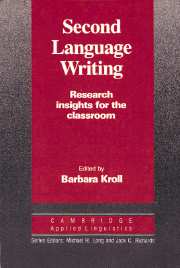Book contents
- Frontmatter
- Contents
- List of contributors
- Series editors' preface
- Preface
- Introduction
- I PHILOSOPHICAL UNDERPINNINGS OF SECOND LANGUAGE WRITING INSTRUCTION
- Chapter 1 Second language composition instruction: developments, issues, and directions in ESL
- Chapter 2 L1 composition theories: implications for developing theories of L2 composition
- Chapter 3 An overview of second language writing process research
- Chapter 4 Coaching from the margins: issues in written response
- Chapter 5 Second language writing: assessment issues
- Chapter 6 Reading–writing connections: toward a description for second language learners
- II CONSIDERATIONS FOR WRITING INSTRUCTION
- Index
Chapter 3 - An overview of second language writing process research
Published online by Cambridge University Press: 05 October 2012
- Frontmatter
- Contents
- List of contributors
- Series editors' preface
- Preface
- Introduction
- I PHILOSOPHICAL UNDERPINNINGS OF SECOND LANGUAGE WRITING INSTRUCTION
- Chapter 1 Second language composition instruction: developments, issues, and directions in ESL
- Chapter 2 L1 composition theories: implications for developing theories of L2 composition
- Chapter 3 An overview of second language writing process research
- Chapter 4 Coaching from the margins: issues in written response
- Chapter 5 Second language writing: assessment issues
- Chapter 6 Reading–writing connections: toward a description for second language learners
- II CONSIDERATIONS FOR WRITING INSTRUCTION
- Index
Summary
Not too long ago, second language acquisition theorist Stephen Krashen claimed that “studies of second language writing are sadly lacking” (1984: 41). To be sure, to that date, few studies had yet been shared with the second language research community, but many studies were being conducted at that time, and shortly thereafter these studies became a part of the growing body of literature on second language (L2) writing research. Of particular concern here is research on second language writing processes. This chapter provides an overview of L2 writing process research, including (1) its relationship to first language (L1) research, (2) a survey of L2 studies, (3) a summary of recurring issues, and (4) suggestions for future research. A few product-based studies are also included because they corroborate the findings of process-oriented research and because many L2 studies include both product- and process-based data (see Connor 1987).
The relationship of L1 research to L2 research
Second language composition textbooks abound, and, as Silva points out in the first chapter of this volume, approaches to teaching L2 writing exist in plenty, supported by ardent, even “evangelical,” advocates and readily accessible materials. Second language composition instruction is, then, well established and much of it follows theory. However, L2 composition teaching has generally not been based on theoretically derived insights gained from L2 composition research, because until the 1980s there was not much L2 research to draw upon in building theory or planning classes.
- Type
- Chapter
- Information
- Second Language Writing (Cambridge Applied Linguistics)Research Insights for the Classroom, pp. 37 - 56Publisher: Cambridge University PressPrint publication year: 1990
- 43
- Cited by



